
1
Frequently Asked Questions
Have a question about formaldehyde-free hardwood plywood technology and its connection to air quality? We’re here to help.
General Product Specification Questions
Are your finishes VOC-free?
Columbia uses 100% solids ultra-violet cured coating of modified acrylate finish that does not emit any Volatile Organic
Compounds (VOCs).
How do I obtain a certificate of compliance for your PureBond products I’ve specified for my green
project?
You may download our MSDS files for PureBond plywood and finishes from our website.
Are PureBond Formaldehyde-Free Hardwood Plywood panels fire rated?
Our standard PureBond veneer core plywood meets a Class C Flame Spread rating as described in the Fire Safety Code. Most
untreated wood products meet Class C. Our PureBond® veneer core panels are not treated with a fire retardant and are not
available with a Class A rating.
Class A core (required by some building codes) may be available for manufacture into a no added urea-formaldehyde (NAUF)
panel using either fire-rated particleboard or fire-rated MDF. The Class A rating is not affected as long as the veneer on either
side does not exceed 1/28″, which ours usually do not. These cores also carry minimum volume requirements and lead times
come into play. When manufactured with our formaldehyde-free, soy based adhesive these panels are compliant with LEED
credit EQ 4.4 and are part of our PureBond® product line. For more information about Flame Spread Ratings click here.
What is an Architectural Panel and how would I specify one?
Architectural plywood is essentially any panel product intended for a high end application. Typically, the grade or custom
specifications are provided by the architect, specifier or designer, but even standard grades such as “AA” or “A” in most species
would be considered applicable to architectural specifications. There are also architectural blue print panels which not only are
specified by the architect, but also are produced to very specific sizes for very specific locations in accordance with an actual
blue print. The Architectural Woodwork Quality Standards Illustrated, published by the Architectural Woodworkers’ Institute
(AWI), incorporated numerous provisions and caveats for specifying face appearance and core performance, and should be
consulted before finalizing any woodworking project specifications. Certain core materials are more suited for certain
applications and should be specified accordingly.

2
Is wheat or any derivative used in the adhesives or manufacturing of your plywood?
At this time we do not include any wheat components in panels or adhesives. Over the years a few panel adhesives may have
included wheat flour as an extender and some panel products have been manufactured using post harvest grain stalk reduced to
fiber and bonded together to form a panel product resembling particle board. Also referred to as “agri-fiber,” this panel product
utilized an isocyonate adhesive to produce a non-wood, formaldehyde-free substrate option for decorative panel producers.
Columbia used to offer this product, but we had to discontinue it because that it is no longer being produced on a commercial
scale.
Is there any lead or mercury in your soy-based adhesive or wood?
No form of lead or mercury is added in the process of manufacturing or finishing our hardwood plywood. Any residual lead or
mercury in our wood, and the amount is infinitesimally small, would be naturally occurring and was absorbed with other
minerals from the air and soil.
Are there any VOCs in your soy-based adhesive or wood?
We utilize small amounts of acetone as a solvent in our patching material, which constitutes less than ½ % of the product by
weight, but almost all of that is immediately volatilized (or pass off as vapor), leaving only inconsequential levels remaining.
Wood naturally contains hundreds of extraneous and heterogeneous compounds in trace amounts. Some of these may be
volatilized at ambient conditions, while many others would be expected to volatilize only during thermal decomposition
(burning). These extraneous compounds are not introduced during the manufacturing process, and if they do exist, would be
through a natural process over which no manufacturer has legitimate control.
Can I use PureBond plywood as a sub-floor?
Our product is rated as a decorative and not structural panel. Just as with any wood product, our panels obviously have
structural properties, but because they are specifically designed for aesthetic applications where the beauty of the wood is to be
seen, we don’t recommend them for structural use or hidden beneath a floor. Most plywood sub-flooring is manufactured with
phenolic resins that, while they do utilize formaldehyde in their formulation, emit only minute traces of formaldehyde gas. The
emissions are so low, in fact that they are below all current standard limits.
I’d like to specify hardwood plywood as a decorative formaldehyde-free flooring treatment. What
do you recommend?
Columbia makes decorative hardwood plywood for furniture, cabinets and architectural millwork. While we have seen plywood
used as a floor system, we do not recommend, nor warrant the use of our plywood for this application. The decorative face
veneer of our plywood is much thinner than you will find in the “wear layer” of an engineered flooring system. And as such our
veneer face would likely wear-through in time.
Is your plywood insect (termite) resistant?
This comes up a lot, and while there may be chemically treated insect resistant wood for use in decorative products, we know of
none in common use. We have not done any testing, but typically wood products used indoors are not susceptible to insect
infestation from subterranean termites. Dry wood termite infestation and powder post beetle infestations are typically avoided
through commonly used household insect control measures.

3
Does Columbia make marine grade plywood?
Marine grade plywood is a designation of the American Plywood Association covered in their product standard PS-1-95. Our
industry does not produce this product under that proprietary designation, although the term is sometimes used generically to
describe our panels made with waterproof glue.
Where is your PureBond plywood made?
All of the core for our veneer core PureBond Formaldehyde-Free Hardwood Plywood is made from responsibly harvested North
American trees and is manufactured at our plants in the US and Canada.
Panel Construction
Can I get PureBond® Hardwood Plywood with an NAUF MDF or Particleboard core?
Yes. Most major composite panel manufactures now offer no added urea-formaldehyde (NAUF) options. When Columbia
laminates hardwood veneers to these NAUF substrates with proprietary, soy-based PureBond® assembly technology the result
is a panel that emits at or below de minimis” levels of formaldehyde and consequently carries the PureBond® label. The panels
described are compliant with LEED EQ 4.4.
It should be noted that NAUF panels are a small, but growing, subset of the total production of a given MDF or particleboard
mill. Particleboard and MDF bonded with urea formaldehyde resins remain as the standard commodity offering in the
marketplace even as emissions have been reduced and standards tightened with composite panel industry response to CARB.
We have found, however, that using most UF MDF or particleboard core with decorative face and back veneers applied using
our soy adhesive, that the resulting formaldehyde emissions are significantly suppressed. Just remember if the project calls for
NAUF composite cores this specification must be communicated during the bid stage and at time of order.
What is in the adhesive in PureBond® Hardwood Plywood?
Columbia’s PureBond technology uses a formaldehyde-free adhesive derived from food-grade soy flour and a wet strength resin
used in printed currency and milk cartons. There is absolutely no added urea-formaldehyde in the adhesive or the components.
What is Phenolic Glue?
Phenolic glue is one of the formaldehyde based family of adhesives commonly used in the production of pressed wood
products. It is primarily used as the glue in structural softwood plywood panels such as CDX. Phenol formaldehyde glues are
actually more efficient in binding the formaldehyde molecules in the cured form, and thus emit formaldehyde at a significantly
lower level than urea formaldehyde glues. They are generally darker in color than urea-formaldehyde resins, and thus may
change the aesthetic of decorative panel products.
What is PVA glue?
PVAs (Polyvinyl acetates) are the common white or yellow carpenter glues on the market. PVA has no added formaldehyde,
but because it forms a thermo plastic bond rather than a rigid thermo set bond, is not considered as strong or water resistant as
PureBond technology.

4
What is a composite panel?
A product consisting of wood, plant particles or fibers, bonded together by an adhesive such as a synthetic resin or binder.
Examples include plywood, particle-board, OSB, and MDF. Visit the Composite Panel Association for more info.
What is MDF?
Medium Density Fiberboard is an engineered wood product made from wood fiber bundles and resin, extruded onto a conveyor
in a “mat” form then pressed to a given thickness. MDF provides a smooth surface, but like particleboard it is denser and
heavier than veneer core. Columbia does not manufacture MDF, but can source it in standard UF and no added urea
formaldehyde options as a core in decorative hardwood plywood construction.
What is Particleboard?
Particleboard is an engineered wood product manufactured from wood chips and a resin, which, like medium density fiberboard
is heavier and does not have the strength of veneer core plywood. Particleboard is a type of composite panel, but it is made up
of larger pieces of wood rather than fiber bundles as used in MDF. Particleboard also provides a smooth surface, but does not
have the strength of veneer core plywood, and because of the coarse nature of the particles, the edges must be treated in some
fashion in the finished product. Columbia does not manufacture particleboard, but can source it in standard UF and no added
urea formaldehyde options as a core in decorative hardwood plywood construction.
What is OSB?
Oriented Strand Board is an exterior (phenolic bonded) engineered wood product made by layering strands of resin saturated
wood on a mat with a specific orientation that approaches veneer core in stiffness. It is frequently used in the construction of
new residential homes as a wall and roof sheathing and as underlayment in certain cases. OSB is a NAUF product by LEED®
definition. Columbia does not currently manufacture OSB and it is seldom used as a core in hardwood plywood panels.
What is Classic Core?
Classic Core utilizes veneer inner plies in all but those adjacent to the face and back. The outer plies are made of thin MDF to
provide the panel with the smooth surface characteristics of MDF and particleboard but with less weight and improved strength.
Columbia makes several types of Classic Core products. Standard Classic Core is manufactured with UF MDF. If your project
requires formaldehyde-free PureBond Classic Core, this must be specified during the bid process and at time of order.
Availability and lead-times for PureBond Classic Core may vary.
What is Veneer Core?
Veneer core is constructed with one or more layers of relatively thick veneers peeled from abundantly available species
typically characterized by their structural properties and usual lack of aesthetic appeal. These veneer layers (or plies) are laid up
and balanced in alternating cross bands for stability and strength. Any decorative thin face of a wood species can be applied to
the front and back of the panel. Compared to MDF and particleboard cores, veneer core offers strength, weight and screw-
holding advantages.
What is Rotary Cut?
Rotary cutting is a method used to peel a log into thin sheets of wood as if unrolled from a spool, like paper towels. Rotary cut
decorative veneer can give a variegated grain appearance, and can vary tremendously. It is usually the least expensive veneer
style. Rotary cutting is the only way to achieve a 48″ wide whole-piece face.

5
What is Quarter Cut?
Quarter slicing (also known as Quarter Sawn, Quarter Cut or Quartered) is a cutting method that involves dividing the log into
quarters and slicing the quarter log on a radial direction approximately perpendicular to the growth rings to produce a straight
grain appearance with the flake from the wood rays typically exaggerated on the surface. It is commonly used with red and
white oaks because of the desired flake effect, but may be used on any species.
What is Plain Sliced?
Plain slicing (also known as Plain Sawn or Flat Cut) a log produces thin veneers that are no wider than the log and have a
pronounced repeating grain pattern. These pieces must be combined to make a plywood face by “matching” the pieces as
desired by the customer.
What is Matching?
Matching is a term typically used in reference to the relationship between one veneer strip or “component” and the adjacent
component in a face consisting of more than one component. The individual components are spliced together employing one of
a number of matching techniques. The most common is book matching, which requires reversing every other component as if
you were opening the pages of a book. The result is a mirror image at the splice line. Slip matching involves splicing each
veneer to the next without turning over any component. This allows the face to have the tight side of the veneer out on each
component, which helps avoid the “barber pole” effect of book matching. Plank matching is a deliberate random mismatch
designed to visually redistribute prominent natural characteristics in some species such as knotty pine. Random
matching requires no aesthetic appeal and is used to produce back veneers which won’t be seen.
The term “matching” may also be used in reference to the relationship of all components within a panel face. Running
matching means the outer components will not be the same width as the inner components due to jointing the log so as to
produce the greatest yield. Running match will be provided unless otherwise specified. Balance matching requires all
components to be the same width and Center matching requires that there be an even number of same width components.
Because of final panel trimming, the outer components of both balance and center matched faces will be slightly narrower than
the other components.
The term “matching” may also apply to the relationship of one panel to the next. Sequence matching means the panels are
produced from faces that were kept in order and numbered during the manufacturing process.
What is the “Barber Pole” effect?
“Barber pole” refers to the alternating dark and light appearance that is occasionally observed in book matched veneer as a
result of the different surface characteristics that exist between the tight side and loose side of a given veneer, especially
noticeable after finishing. Barber pole effect can be avoided by using matching techniques that utilize tight-side-out assembly.
What is Tight Side and Loose Side?
Conventional means of peeling or slicing a log results in the development of minute fractures known as lathe checks on the side
of the veneer adjacent to the knife and closer to the center of the log as the veneer was cut. The side of the veneer having the
lathe checks is the loose side, while the opposite side is the tight side. The loose side will tend to absorb more finishing material
than the tight side, which sometimes results in a dark/light appearance called the “barber pole” effect.

6
What is a Calibrated panel?
A calibrated panel is typically a veneer core panel whose core was produced in a separate step and sanded to strict thickness
tolerances before the outer decorative veneers are applied. Natural variation such as density, moisture absorption, and physical
properties, combined with manufacturing variation results in thickness fluctuations in all wood panels. Veneer core typically
has more potential thickness variation than engineered cores. Product Standard ANSI/HPVA HP-1-2009 includes limitations for
thickness variation for all decorative panel products. A calibrated panel is designed to provide even tighter tolerance
restrictions. Columbia’s brand of calibrated core for hardwood plywood is called JayCore™ and KayCore™.
Does Columbia’s PureBond plywood meet ANSI/HPVA standards?
Columbia Forest Products plywood conforms to all of the requirements established in ANSI/HPVA HP-1-2009 developed
cooperatively with the industry and published by the Hardwood Plywood and Veneer Association. Full responsibility for the
conformance of this product to the Standard is assumed by Columbia Forest Products, Greensboro NC.
About Indoor Air Quality
What is formaldehyde?
Formaldehyde is a chemical compound with the formula CHOH or CH2O. It is a colorless, pungent gas and common volatile
organic compound (VOC). It was first reported by the Russian chemist Aleksandr Butlerov (1828-1886.) Formaldehyde is used
as a component in many common products including disinfectants and preservatives, clothing and textiles, plastics and coatings.
It is also a by-product of combustion and certain other natural processes. Human beings and plant life actually produce small
amounts of formaldehyde on a daily basis!
When reacted with urea it produces a hard thermoset resin. These resins are commonly used in permanent adhesives such as
those used in hardwood plywood, particleboard and medium density fiberboard (MDF). Urea formaldehyde can “off-gas” for a
period of time after the manufacturing process is complete.
What is a VOC?
The United States Environmental Protection Agency (EPA) defines a VOC (or Volatile Organic Compound) as any organic
compound that participates in a photoreaction. The term may refer both to well characterized organic compounds and to
mixtures of variable composition. Volatile Organic Compounds are carbon based chemical compounds, found in thousands of
household products that vaporize into a gas at room temperature like paint thinners, cleaning products, carpeting and even room
deoderizers . Once inhaled, these toxins can be stored within the body, potentially causing long-term health effects.
What is no added urea formaldehyde (NAUF)?
A term used in the construction industry to describe materials that have no added urea-formaldehyde in the manufacturing
process. The term refers specifically to the binders used in composite panel production. Alternative adhesive systems that
qualify for the NAUF category would include: Phenol Formaldehyde (PF), Poly vinyl acetate (PVA) and Soy. LEED
(Leadership in Energy and Environmental Design) has also adopted the no added urea-formaldehyde terminology under the
credit EQ 4.4. The popularity of LEED has driven this term into the mainstream as the public becomes more concerned with
issues of indoor air quality.

7
What does “formaldehyde-free” mean?
When we say PureBond technology is ‘formaldehyde-free,’ we’re describing the way our hardwood plywood panels are
comprised of no added urea formaldehyde components and assembled with zero formaldehyde adhesives. In other words, we
don’t add any formaldehyde to the products we call “formaldehyde-free,” whether in the resin or the wood that makes up the
core of the panel. For example, our PureBond Veneer Core Hardwood Plywood is comprised of core layers of dried wood
(mostly fir, pine, poplar or aspen), bonded together using our innovative, soy-based PureBond technology.
Can PureBond® panels be VOC free?
It might surprise many folks, but natural wood and bamboo are not VOC-free materials. Naturally occurring compounds
generated by trees while growing, called extractives, are fairly well known and generally published in wood science research.
The most important of these naturally occurring groups of potential materials are the polyphenols and oleoresins. Oleoresins,
more common in softwoods, provide turpentine, oils, and rosin. Polyphenols are more prevalent in hardwoods, and include
tannins, anthocyanins, flavones, catechins, kinos, and lignans.
Natural wood may also contain a wide variety of gums, tropolones, fats, fatty acids, waxes, and volatile hydrocarbons as well.
Certain species, most notably those generically called cedar, are also well known for their aromatic qualities. The attractive
aromas of cedar are a result of the volatilization of organic compounds intrinsic to these species. These organic compounds are
not identified as VOCs by the EPA but can still be detected by the human nose as an odor.
Typically, the majority of compounds found in wood are volatilized (flashed off) at higher temperatures such as those found in
kilns or veneer dryers. That said, the matter becomes more complex in that the normal drying process may result in existing,
natural compounds combining with heat and moisture to form new compounds which were not present in the green wood to
begin with.
This may include acetaldehyde which could volatilize at room temperature from freshly manufactured, raw wood panels.
Acetaldehyde occurs naturally in coffee, bread, and ripe fruit, and is produced by plants as part of their normal metabolism.
Although these volatile elements are commonly found in many wood species, they are generally non-toxic to most people.
People with extreme sensitivity may want to stick with species like maple or birch which are the least reactive in an indoor
environment.
About Regulations and Certifications
What is CARB?
The California Air Resources Board (CARB) is a department of the California Environmental Protection Agency. On April 26,
2007, CARB approved an airborne toxic control measure (ATCM) to reduce formaldehyde emissions from composite wood
products including hardwood plywood, particleboard, medium density fiberboard, thin medium density fiberboard and also
cabinets, furniture and other finished products made with composite wood products. The first set of formaldehyde emissions
limits went into effect January 1, 2009. PureBond® formaldehyde-free hardwood plywood technology meets the toughest Phase
2 emission limits set by CARB. For more information on the ATCM visit CARB at
www.arb.ca.gov/toxics/compwood/compwood.htm.

8
What is LEED®?
LEED® (Leadership in Energy and Environmental Design), established by the U.S. Green Building Council (USGBC), is a
green building rating system accepted as the national benchmark for the design, construction, and operation of high-
performance green buildings. As a third-party certification program, LEED gives building owners and operators the tools they
need to have an immediate and measurable impact on their buildings’ performance. LEED promotes a whole-building approach
to sustainability by recognizing performance in five key areas of human and environmental health: sustainable site
development, water savings, energy efficiency, materials selection and indoor environmental quality. PureBond®
Formaldehyde-Free Hardwood Plywood may contribute to LEED EQ: 4.4 credits for Low-Emitting Materials. Other credits are
possible; see our list of LEED-compliant products. For more information on LEED visit www.usgbc.org.
What is the USGBC?
The U.S. Green Building Council (USGBC) is a non-profit organization that certifies sustainable businesses, homes, hospitals,
schools, and neighborhoods. USGBC is dedicated to expanding green building practices and education, using its LEED® Green
Building Rating System™. The USGBC’s mission is to transform the way buildings and communities are designed, built and
operated, enabling an environmentally and socially responsible, healthy, and prosperous environment that improves the quality
of life. The USGBC’s vision: “Buildings and communities will regenerate and sustain the health and vitality of all life within a
generation.”
LEED® is one of many programs this organization oversees. For more information, visitwww.usgbc.org.
What is FSC®?
The Forest Stewardship Council™, founded in 1992, is an International non-profit organization that concerns itself exclusively
with the maintenance, preservation, conservation and appropriate use of the world’s forests in relation to their commercial use.
Their certification system regulates and monitors everything about a forest stand including harvest management, pesticide use
and indigenous people’s rights within that forest, as well as the additional materials used within any FSC® certified product.
Columbia has an FSC “Chain of Custody” certification and can supply FSC-Certified wood products. In 1998, Columbia Forest
Products was the first decorative hardwood plywood and veneer company in North America to secure Chain of Custody
certification through the Rainforest Alliance and bears the COC number SW-COC-000065. More information on FSC and its
mission can be found on the FSC global website [www.fsc.org], FSC US website [www.fscus.org] and FSC Canada
[www.fsccanada.org].
-
 1
1
-
 2
2
-
 3
3
-
 4
4
-
 5
5
-
 6
6
-
 7
7
-
 8
8
Ask a question and I''ll find the answer in the document
Finding information in a document is now easier with AI
Related papers
-
Columbia Forest Products 3370 Operating instructions
-
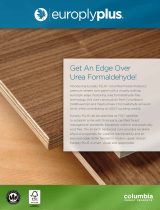 Columbia Forest Products 3783 Specification
Columbia Forest Products 3783 Specification
-
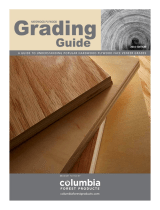 Columbia Forest Products 2595 User guide
Columbia Forest Products 2595 User guide
-
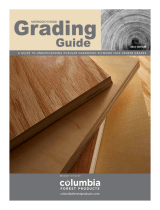 Columbia Forest Products 3752 User guide
Columbia Forest Products 3752 User guide
-
PureBond 3721 User guide
-
Columbia Forest Products 332021 User guide
-
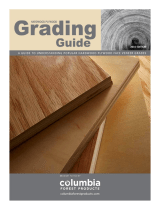 Columbia Forest Products 2366 User guide
Columbia Forest Products 2366 User guide
-
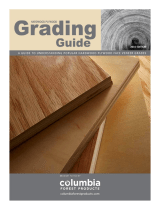 Columbia Forest Products 2793 User guide
Columbia Forest Products 2793 User guide
-
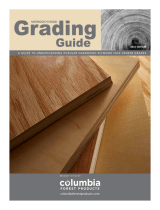 Columbia Forest Products 3370 User guide
Columbia Forest Products 3370 User guide
-
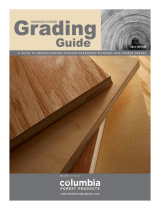 Columbia Forest Products 5329 User guide
Columbia Forest Products 5329 User guide
Other documents
-
 Greenes RC41 Installation guide
Greenes RC41 Installation guide
-
United Nursery 24925 User manual
-
Loctite 908570 User guide
-
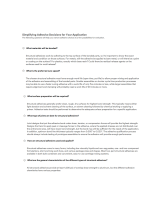 GBTRICON SG_B074DV1YRL_US User guide
GBTRICON SG_B074DV1YRL_US User guide
-
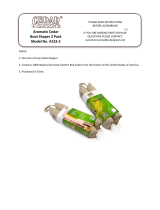 CEDAR GREEN A152-2 Operating instructions
CEDAR GREEN A152-2 Operating instructions
-
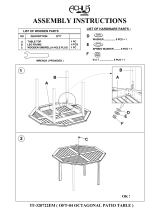 Achla Designs OFT-04-P User guide
Achla Designs OFT-04-P User guide
-
HDX 1399963 User guide
-
Dimensions 225515 FAQ
-
MegaHome JW179 User manual
-
American Pro Decor 5APD10626 Installation guide


















